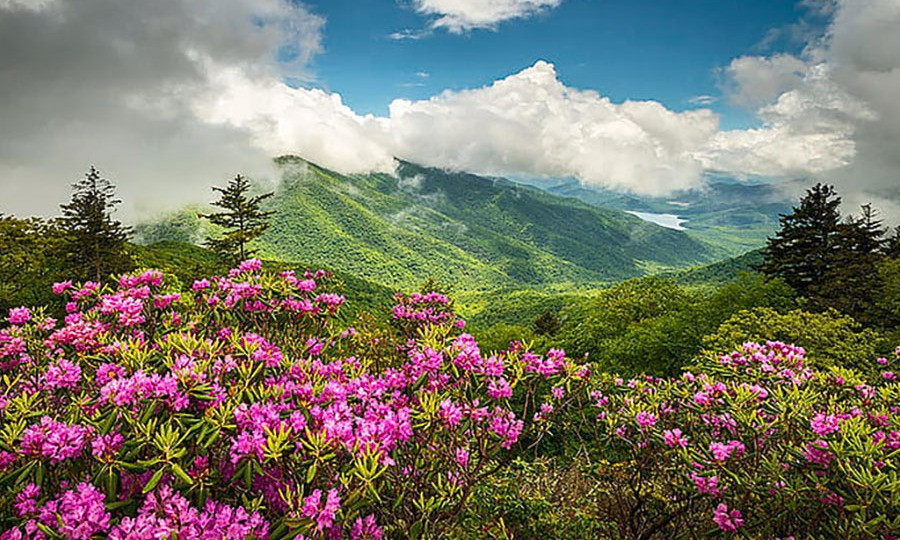The Blue Ridge Parkway is a scenic two-lane highway that follows the crest of the Appalachian Mountains from southwestern North Carolina to central Virginia. Part of the greater Appalachian Mountain range, the iconic Blue Ridge Mountains were uplifted from the Earth’s crust over one-billion years ago. These rugged mountains were once sparsely inhabited and rarely visited for recreation. Today, thanks in-part to the Blue Ridge Parkway, millions are able to enjoy the ancient Blue Ridge Mountains every year – relishing long-range vistas from the comfort of their own vehicles or stopping to explore countless hiking trails that adjoin this picturesque mountain byway. Whether it’s the vibrant pink Rhododendron bloom in June or the blazing fall colors that blanket the mountains every fall, each winding curve along the Blue Ridge Parkway unveils a unique Appalachian display that will take your breath away.
Residents of Ashe County and the surrounding area are blessed to have one of the most scenic roads in the world right in their backyard. Twenty of the Parkway’s 469 miles either border or pass directly through Ashe County, and area residents are a short drive from some of the most renowned sections of the entire road. The Mountains to the Sea Trail, an epic footpath that traverses North Carolina, parallels the Blue Ridge Parkway though Ashe County. Julian Price Park, Grandfather Mountain, E.B. Jeffress Park, Moses Cone Manor, and Doughton Park are a few additional nearby options that are sure to inspire a sense of awe and appreciation for the majestic Appalachian Mountains and their rich history.
In the years of the Great Depression, President Franklin D. Roosevelt visited a Civilian Conservation Corps (CCC) group in Virginia as they worked to complete Skyline Drive through the recently established Shenandoah National Park. Around one year before Roosevelt’s visit, the Great Smoky Mountains National Park was also founded in the mountains of western North Carolina. With the automobile becoming an increasingly common mode of transportation, visitors flocked from broader areas to visit both scenic parks – perhaps turning to nature to escape the day-to-day stresses that affected nearly everyone who lived through the 1930s. Roosevelt aptly envisioned a scenic highway to connect these two iconic national parks.
Not only was the Parkway a unique idea to connect two national parks, but also a means to put thousands of Americans back to work. Skilled engineers, architects, landscape architects, private contractors, and many more with a willingness to work suffered from widespread unemployment – their valuable skills left unused. Families, especially in rural Appalachia, were particularly hard-hit. Thus, for more reasons than one, the idea for our cherished “Appalachian Scenic Highway” (later to be renamed Blue Ridge Parkway) was formed.
Once obtaining support from US Congress, Roosevelt’s administration was able to determine necessary details to begin construction. Right-of-ways were to be purchased by states and then transferred to the National Park Service, creating a single, narrow national park spanning hundreds of miles along the crest of the Blue Ridge Mountains. At times, the right-of-way for the road is as narrow at 200 feet. In the early days of planning the route for the Blue Ridge Parkway, North Carolina and Tennessee clashed over competing proposed routes: one through northeastern Tennessee, and the other through northwestern North Carolina. North Carolina’s congressman Bob Doughton is credited with ensuring NC’s route was chosen, giving Watauga, Ashe, Wilkes, and Alleghany Counties the Parkway we all enjoy today.
Construction began near North Carolina’s Cumberland Knob in September 1935, and ground was formally broken in Virginia a few months later. Progress was slow. Weather, rugged terrain, reluctant landowners, and a lack of reliable mapping made the construction of the Blue Ridge Parkway a challenging endeavor. Minimizing the impact to the fragile habitats along the crest of the Blue Ridge Mountains was always a priority. There were 26 tunnels and hundreds of miles of narrow bench cuts constructed through high mountain passes. All but one particularly rugged section along Grandfather Mountain’s southeastern slopes were finally completed by 1966. The Linn Cove Viaduct, a short drive on the Parkway from Ashe County, was not opened until 1987. “The Viaduct,” as it is known by locals, is a modern engineering marvel – quite literally a highway in the sky built next to Grandfather Mountain to preserve its natural beauty.
The Blue Ridge Parkway, and the splendor of the Appalachian Mountains in northwestern North Carolina, make Ashe County an enticing place to call home. Many of our properties are within a few miles of the Blue Ridge Parkway. Come visit our special corner of North Carolina or check out the listings on our website to learn why Ashe County is the perfect place for your new mountain escape.



